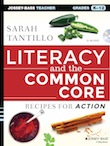Analyze the Trajectory of an ELA Standard

No matter what level or subject, teachers working with the Common Core need to know the standards for more than just the grade they teach.
Here’s why: the Common Core lays out standards across a “trajectory” of learning. Each year’s knowledge and skills should build on the year before and prepare students for the year to come. As a teacher, you need to know how prepared your students are supposed to be when they enter your classroom, as well as what your responsibilities will be during the time they’ll spend with you.

“I can tell you where each of my students are on this chart. They’re all in seventh grade, but looking at the descriptions, I can see that three of my students are on the fifth-grade level, about five are on the sixth-grade level, and the rest are where they should be. And now I need to think about how I’m going to get them all up to speed, not just on the seventh-grade level but to also be ready for eighth grade.”
To get a sense of what it means to analyze a standard’s trajectory, let’s consider the trajectory of RIT Standard #1.
A CCSS trajectory PD exercise
I have modeled how to analyze these standards with the first few grades (underlining key word differences and jotting notes in the right-hand column) and left the rest blank for teachers to use as a PD exercise. You can find a FREE digital version of this chart, called “RIT Standard 1 Trajectory Analysis Chart,” at my Literacy Cookbook standards page (or you can download it here).
This analysis process works best if participants pair up to discuss their interpretations, then share out with the whole group. Partnering generates more ideas (and useful questions) than solo independent work.
| STANDARD | DIFFERENCE FROM PREVIOUS GRADE? | |
| RIT K.1 | With prompting and support, ask and answer questions about key details in a text. | N/A |
| RIT 1.1 | Ask and answer questions about key details in a text. | Ask questions without prompting. |
| RIT 2.1 | Ask and answer such questions as who, what, where, when, why, and how to demonstrate understanding of key details in a text. | Use 5W’s and H questions, not just any old questions. |
| RIT 3.1 | Ask and answer questions to demonstrate understanding of a text, referring explicitly to the text as the basis for the answers. | Refer to the text when answering questions. |
| RIT 4.1 | Refer to details and examples in a text when explaining what the text says explicitly and when drawing inferences from the text. | |
| RIT 5.1 | Quote accurately from a text when explaining what the text says explicitly and when drawing inferences from the text. | |
| RIT 6.1 | Cite textual evidence to support analysis of what the text says explicitly as well as inferences drawn from the text. | |
| RIT 7.1 | Cite several pieces of textual evidence to support analysis of what the text says explicitly as well as inferences drawn from the text. | |
| RIT 8.1 | Cite the textual evidence that most strongly supports an analysis of what the text says explicitly as well as inferences drawn from the text. | |
| RIT 9-10.1 | Cite strong and thorough textual evidence to support analysis of what the text says explicitly as well as inferences drawn from the text. | |
| RIT 11-12.1 | Cite strong and thorough textual evidence to support analysis of what the text says explicitly as well as inferences drawn from the text, including determining where the text leaves matters uncertain. |
If you go to the Common Core State Standards website, you’ll find some useful PDF files (and don’t forget to read the Appendices!). But if you’re actually writing curriculum, you’ll need tools that are even more useful, which is why I’ve created a K-12 ELA Common Core Standards Tracking Spreadsheet, available to members of the TLC Website. To see just how useful this kind of tracking tool can be, check out this free sample of the 4th-grade ELA Common Core Standards Tracking Spreadsheet.

































